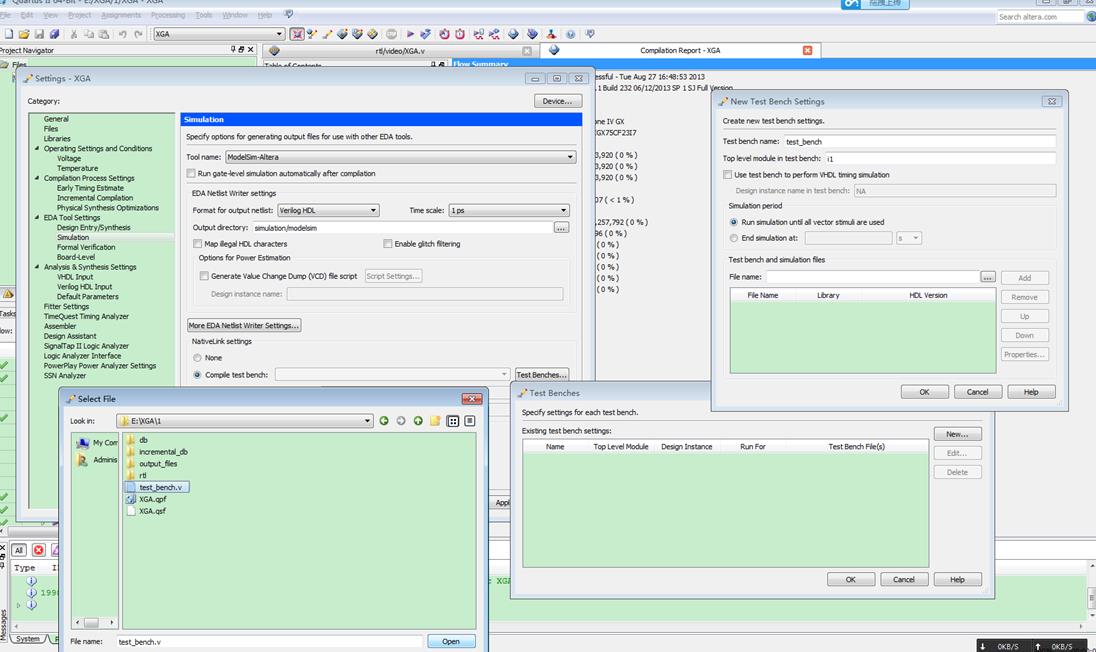

- #Altera modelsim install#
- #Altera modelsim update#
- #Altera modelsim 32 bit#
- #Altera modelsim code#
- #Altera modelsim Pc#
Just make a clock on button1 to simulate pushing the button Map the ports from the dut to this testbench dut = device under test (same name as top project from Quartus) Create an implementation of the entityĪrchitecture testbench1 of test_counter_3bit is Here is the text for a very simple testbench. So create a new one, File -> New -> Source -> VHDL We need to create a testbench to use to simulate the project. It will be in the work library when finished. Work is the default name and is fine.Ĭompile the counter_3bit.vho file. Select the simulation/modelsim directory that is inside your project directory. Start Modelsim and do File -> Change Directory We will use Modelsim-Altera to perform a functional simulation.

Start the pin planner.ĭouble-click in the location to either select or type in the pins.Īfter assigning pins, recompile the project! Successful compilation will give this window. If you get errors, read through them to try to figure out the problem. Do not check the "Run gate-level simulation automatically after compilation" box.Ĭompile the project (click the purple triangle). Go to Assignments -> Settings and select Modelsim-Altera in the Tool name field. So we need to tell Quartus to generate the files needed by Modelsim. Later, we are going to use Modelsim to simulate our project. Use the 'Orthogonal Node Tool' to connect the parts so that your block diagram looks the same as the one below. The block diagram should now look something like this. Repeat, but this time place two input pins. Find the tff, you'll want to place three in your block diagram. Click the Symbol Tool (located next to the A in the top bar of the block diagram) to bring up the symbol window. We need to place parts in our block diagram. Family: Max II, Device: EPM2210F324C3 and click FINISH.įile -> New and choose "Block Diagram/Schematic File" from the window that comes up.

Hint, don't start the name with a number.Ĭhoose the device on our board. Test by running vsim and hopefully you will be greeted by the ModelSim GUI.After starting Quartus, do File -> New Project Wizard Now we need to edit the vsim launch script to ensure the new freetype libraries are used:Īnd underneath add the following new line: Sudo cp ~/Downloads/freetype-2.4.12/objs/.libs/libfreetype.so*. Note you may need to edit the directory paths to match those used on your system.
#Altera modelsim install#
As they are necessary to run ModelSim we need to copy them into the install directory so they don't get lost and then modify ModelSim's vsim script to use the new libraries instead of the system wide versions.Ĭhange directory to the directory where you installed ModelSim, /opt/altera/13.1/modelsim_ase/, on my system. The finished libraries are now available inside the " objs/.libs" directory. Sudo apt-get build-dep -a i386 libfreetype6 Now install the build dependencies needed for libfreetype6, extract the source (using tar) and configure and build libfreetype:
#Altera modelsim code#
For an unknown reason ModelSim has an issue with modern versions shipping in Arch and Ubuntu 14.04.įirst download the source code of freetype 2.4.12: Then you probably need to build a new version of freetype, a font setting library and modify ModelSim to use it. ** Fatal: Read failure in vlm process (0,0) Problem number two: If you have the following error when running vsim:
#Altera modelsim update#
Sudo apt-get update sudo apt-get install build-essential sudo apt-get install gcc-multilib g++-multilib \Įxpat:i386 fontconfig:i386 libfreetype6:i386 libexpat1:i386 libc6:i386 libgtk-3-0:i386 \ Luckily this is fully supported on a modern Linux like Ubuntu 14.
#Altera modelsim 32 bit#
On Linux this requires us to install the 32 bit versions of the libraries that it depends on.
#Altera modelsim Pc#
Problem number one: The free version of ModelSim Altera Edition is 32 bit only while the normal Linux PC will be 64 bit. This article mostly adapts the work done by the Arch Linux crew.

Luckily I had lots of helpful information on the internet (major sources linked below) to get it going. Trying to get a version of ModelSim running on a very modern version of Linux often presents challenges.


 0 kommentar(er)
0 kommentar(er)
